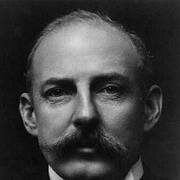F. Marion Crawford (1854–1909)
Author of Khaled
About the Author
F. Marion Crawford was born on August 2, 1854, in Bagni de Lucca, Tuscany, Italy. He was the son of the American sculptor Thomas Crawford. He was educated by a French governess; then at St. Paul's School, Concord, N.H.; in the quiet country village of Hatfield Regis, under an English tutor; at show more Trinity College, Cambridge, where they thought him to become a mathematician; at Heidelberg and Karlsruhe, and at the University of Rome, where a special interest in Oriental languages sent him to India with the idea of preparing for a professorship. He spent a short time as a newspaper editor there. His first novel, Mr. Isaacs, was published in 1882. During his lifetime, he wrote over forty novels and one play, Francesca da Rimini. His novels include Dr. Claudius, A Roman Singer, A Cigarette Maker's Romance, The Witch of Prague, The Heart of Rome, and The Diva's Ruby. He died on April 9, 1909. (Bowker Author Biography) show less
Image credit: Credit: Zaida Ben-Yusuf, circa 1900
(LoC Prints and Photographs Division,
LC-USZ62-83072)
(LoC Prints and Photographs Division,
LC-USZ62-83072)
Series
Works by F. Marion Crawford
The Upper Berth / La litera de arriba & By the Waters of Paradise / Junto a las aguas de paraíso (1999) 15 copies, 1 review
Marzio's Crucifix and Zoroaster (The Complete of F. Marion Crawford, in 32 Volumes, Authorized Edition) (2007) 12 copies, 1 review
Love in idleness. A Bar Harbour tale 6 copies
Love in Idleness: A Tale of Bar Harbor & Marion Darche: A Story Without Comment (The Novels of F. Marion Crawford) (1894) 6 copies
Delphi Complete Works of F. Marion Crawford (Illustrated) (Delphi Series Ten Book 16) (2019) 6 copies
By The Waters Of Paradise 3 copies
The Witch of Prague and Other Crawford Horror Classics: The Screaming Skull, The Doll's Ghost, The Upper Berth,… (2019) 2 copies
Adam Johnstone's Son [and] A Rose of Yesterday (Vol. 26 of 32, The Complete Works of F. Marion Crawford) (2004) 2 copies
The Best Horrors by F. Marion Crawford: The Witch of Prague, The Upper Berth, Khaled, For the Blood Is the Life, The… (2019) 1 copy
Gespenster klopfen an. Texte von: M. Twain, G.A. Bequer, G. d. Maupassant, J. P. Hebel, E.T.A. Hoffmann, Fr. v.… (1981) 1 copy
The Collected Complete Works of F. Marion Crawford (Huge Collection Including A Lady of Rome, Wandering Ghosts, The… (2017) 1 copy
The Upper Berth, For the Blood is the Life, and Other Horrors: The Best Weird Fiction and Ghost Stories of F. Marion… (2018) 1 copy
Taquisara. Vol 1 (only). 1 copy
The Art of Rome 1 copy
Associated Works
American Fantastic Tales: Terror and the Uncanny from Poe to the Pulps (2009) — Contributor — 266 copies, 3 reviews
Ghostly Tales: Spine-Chilling Stories of the Victorian Age (2017) — Contributor — 203 copies, 16 reviews
The Vampire Archives: The Most Complete Volume of Vampire Tales Ever Published (2009) — Contributor — 188 copies, 5 reviews
The Mammoth Book of Victorian and Edwardian Ghost Stories (1995) — Contributor — 170 copies, 4 reviews
The Valancourt Book of Victorian Christmas Ghost Stories, Volume One (2016) — Contributor — 144 copies, 6 reviews
In the Shadow of Edgar Allan Poe: Classic Tales of Horror, 1816-1914 (2015) — Contributor — 91 copies, 1 review
H.P. Lovecraft's Book of the Supernatural: 19 Classics of the Macabre, Chosen by the Master of Horror Himself (2006) — Contributor — 91 copies, 2 reviews
Great Weird Tales: 14 Stories by Lovecraft, Blackwood, Machen and Others (2011) — Contributor — 58 copies
Les cent ans de dracula - 8 histoires de vampires de goethe a (1999) — Contributor — 37 copies, 2 reviews
The Ghost of Fear and Others: H. P. Lovecraft's Favorite Horror Stories Vol. 1 (2014) — Contributor — 26 copies
The Rivals of Dracula: Stories from the Golden Age of Gothic Horror (2016) — Contributor — 20 copies, 3 reviews
Isaac Asimov Presents the Best Horror and Supernatural of the 19th Century (1983) — Contributor — 15 copies, 1 review
Library of the World's Best Mystery and Detective Stories: American (1908) — Contributor — 15 copies, 1 review
Great American Ghost Stories: Chilling Tales by Poe, Bierce, Hawthorne and Others (2008) — Contributor — 10 copies
Tales of the Undead: Vampires and Visitants (1947) — Contributor, some editions — 9 copies, 1 review
The Forgotten Classics of Mystery, Volume II: An Omnibus of American Mysteries (1959) — Contributor — 5 copies
Prize stories from Collier's, 5 volumes — Contributor — 1 copy
Tagged
Common Knowledge
- Legal name
- Crawford, Francis Marion
- Birthdate
- 1854-08-02
- Date of death
- 1909-04-09
- Gender
- male
- Nationality
- USA
- Birthplace
- Bagni di Lucca, Italy
- Place of death
- Sorrento, Italy
- Places of residence
- Bagni di Lucca, Italy
India
New York, New York, USA
Boston, Massachusetts, USA
Sorrento, Italy - Education
- University of Cambridge
University of Heidelberg
University of Rome
Harvard University - Occupations
- novelist
- Relationships
- Howe, Julia Ward (aunt)
Howe, Samuel (uncle)
Fraser, Mary Crawford (sister) - Organizations
- American Academy of Arts and Letters (Literature, 1898)
- Short biography
- Francis Marion Crawford (August 2, 1854 – April 9, 1909) was an American writer noted for his many novels, especially those set in Italy, and for his classic weird and fantastic stories.
Members
Reviews
Lists
Awards
You May Also Like
Associated Authors
Statistics
- Works
- 115
- Also by
- 95
- Members
- 1,489
- Popularity
- #17,248
- Rating
- 3.9
- Reviews
- 53
- ISBNs
- 358
- Languages
- 12
- Favorited
- 3



















